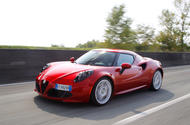
An Italian Boxster from £40k for the tarmac-loving Alfisti – here’s what to check and avoid
Ten years since it was launched, the Alfa Romeo 4C still turns heads, still quickens pulses, still provokes debate.In the intervening years, the Alpine A110 has arrived and proved that it’s possible to have as much fun but be comfortable, too.Yet it doesn’t pluck the heartstrings in the same way, at least if your ticker is stamped ‘Alfa Romeo’. Production of the 4C ran from 2013 to 2020, and today there are only about 475 examples in the UK.For some years, few used ones came to market, but just recently more have begun to emerge. As this was written, around 20 were being offered at prices starting from £40,000. That compares with £35,000 two years ago.Proving that Alfisti prefer to drive their cars than salt them away, many have done reasonable mileages, a few around 30,000.The 4C was offered in two flavours: original coupé and Spider, the latter launched in 2015 with a sticker price of £59,500 over the coupé’s £52,000.They are constructed around a strong yet light carbonfibre tub with aluminium subframes front and rear. The body panels are made of a composite material that flexes on impact and doesn’t dent, although it will tear if struck hard enough.The steering is unassisted and the suspension by a double-wishbone arrangement at the front and MacPherson struts behind. The engine is a mid-mounted 1.75-litre turbo petrol four-pot.It produces 237bhp and drives the rear wheels through, when it behaves, a lightning-quick, six-speed dual-clutch automatic transmission.With the coupé weighing only 925kg and the Spider 1080kg, 0-62mph takes 4.5sec, but its in-gear acceleration impresses more.At launch, the 4C attracted mixed press. Everyone loved its looks and rawness, but a few testers, including Autocar’s, criticised its unruly handling and steering on all but handling and steering on all but the smoothest of surfaces. Alfa took note and recalled early cars for tweaks to their geometry.The first coupés could be ordered in Launch Edition trim, offering unique paint colours, 18in and 19in forged teledial wheels in place of the standard cast 17in and 18in items, carbon-surround bi-LED headlights, specially calibrated suspension and a ‘Race’ exhaust.The launch of the Spider ushered in further steering and geometry improvements and even a rear anti-roll bar, plus an upgraded interior featuring leather trim. It gained improved headlights, too. Subsequently, these tweaks were shared with the coupé. To celebrate 50 years since the Duetto’s starring role in The Graduate, a special edition Spider with the larger wheels, a race exhaust, carbon bits and special colours arrived in 2016.A very limited-run Competizione C4 edition followed in 2018, then in 2019 it was all over for the coupé and a year later for the Spider.Options included an Akrapovic exhaust (rare but desirable) and a Race Pack featuring a loud race exhaust, uprated suspension and those larger 18in and 19in wheels.There are many aftermarket upgrades, including those by the respected Alfa Workshop. Joe Quinn at Supercar Sourcing has owned a few 4Cs and reckons the one to have is a 2017 coupé or Spider in Rosso red with teledial wheels and black leather.With more 4Cs looking for new homes, now is the time to buy before prices rise further.Alfa Romeo 4C common problems Engine: It’s proving to be reliable, even past 70,000 hard-driven miles. With the quiet, standard exhaust fitted, you can at least hear all is well with the turbo, pulley tensioner and valves, but the optional racing exhaust is more thrilling. Service intervals are every 12,000 miles or 12 months. Jobs include general bolt tightening, although some owners say this is not necessary. The timing belt should be changed every 60,000 miles or five years.There are increasing reports of the alternator failing and the battery management module wrongly telling the car its battery isn’t fully charged.Exhaust: Listen for the standard system vibrating badly at idle (a problem likely to be caused by a perished flexi-pipe) and also for the silencer blowing.Gearbox: Check the TCT thoroughly on the test drive. Changes should be quick. Any hesitation, random selection or even the ’box going into neutral should be cured by restarting the car several times to clear the fault codes or a dealer software or firmware update, but if the problem lingers, hurry away.One or two owners have reported lumpy downchanges on a closed throttle in auto and manual modes and even ‘slipping’ between gears.Chassis, wheels and suspension: Check workshop receipts for evidence of periodic bolt-tightening. Subframes are the only parts that rust. On an early car, turn the steering wheel listening for creaking, most likely from the main bushes on the lower wishbones. The whole assembly has to be replaced, but fortunately the bushes were upgraded on later models. Owners rate Michelin Pilot Super Sport tyres over the original Pirelli P Zeros for their less nervy handling.Body: The composite body is soft and returns to shape after a casual knock, but the paint (especially the red) is also soft and chips and scratches easily. The presence of protection film on the nose and wings suggests a careful owner. Check the central rear brake light’s LEDs work. Interior: Check the deep sills for knocks and scrapes and the dashboard for delamination or ‘bubbling’. As our summers become hotter, this last issue may become more common. It’s unsightly and expensive to put right.
Source: Autocar